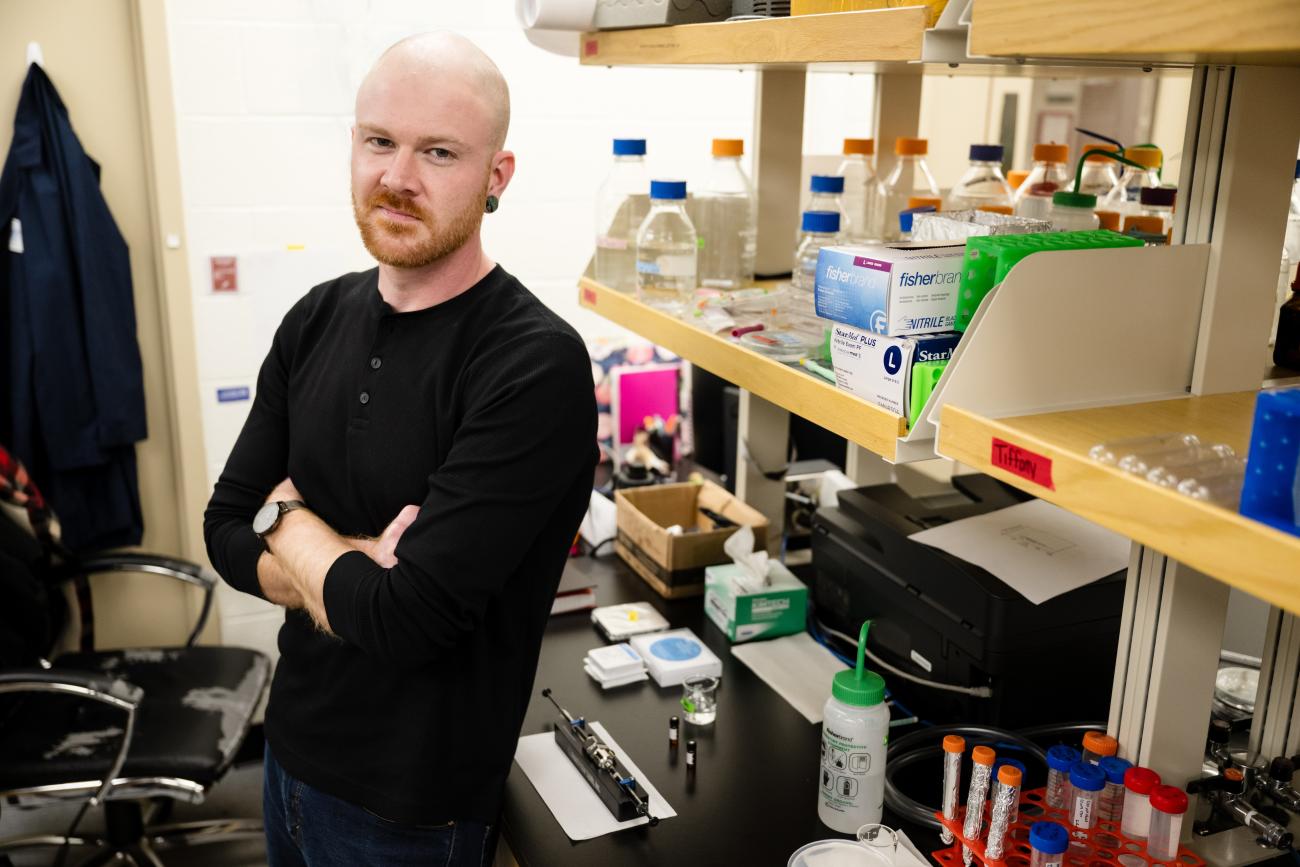From the Bottling Line to the Biochemistry Lab
Dane Santa didn’t follow a conventional path to a Ph.D. program in biochemistry.
Santa had no real aspirations of going to graduate school six years ago. He was working on the packaging team at Samuel Adams Brewery in the Lehigh Valley, and part of his job included participating in quality assurance panels. This involved tasting and smelling beer to help identify any off-flavors or odors, like the flavor compound diacetyl, which gives beer the scent of movie theatre popcorn.
As Santa sipped and sniffed the beer, he discovered he had a taste for science.
“Those panels introduced me to the molecules of beer,” he said. “I got really interested and always stayed after to talk with the sensory scientists to learn as much as possible.”
“The more I learned about the science of beer, the more I realized I didn’t want to bottle beer anymore.”
Santa enrolled in community college classes at the age of 27 to pursue his interest in the physical sciences and was admitted to the honors program in biology. He eventually transferred to East Stroudsburg University and then started his Ph.D. program at Lehigh two years ago. When Santa went back to school, he discovered microbiology—and he quickly became as intrigued by the field as he was by the science of beer.
“When I get really excited about something, I consume it until I know everything about it,” he said.
He’s now based in the lab of professor Nathan Wittenberg, which specializes in bioanalytical chemistry. Santa’s research focuses on key molecular interactions related to diseases like Alzheimer’s, Parkinson’s, cancer and cardiovascular issues.
Santa recently was awarded a Graduate Research Fellowship from the National Science Foundation. This three-year award will support his research and allow him to build a mentorship program for community college students, to help empower others to follow a less conventional path to an advanced degree in the sciences.
“As a community college student, I didn’t have access to traditional research opportunities,” Santa said. “This award will help me create opportunities for community college students to get experience in a research lab.”
A major component of Santa’s research focuses on how environmental stressors like pollutants, heavy metals and cigarette smoke can damage lipids and compromise cell membranes, leaving cells more vulnerable, as the primary function of the membrane is to keep things from getting in or out of a cell. When the lipid is damaged, or oxidized, it can accelerate cellular damage, activate inflammatory immune pathways and lead to the progression of diseases like neurological disorders, high blood pressure and cancer.
“We know that this is happening from a biological perspective, but a lot remains unknown about the mechanisms and interactions that fuel it,” he explained.
Santa is trying to uncover new information about those key interactions, which could help inform new therapies to prevent and treat the long list of diseases that are connected to these molecular underpinnings.
To conduct this research, Santa makes synthetic lipid membranes, which are simplified versions of a cell membrane. While a real cell membrane contains thousands of biomolecules, Santa strips the membrane down to just one relevant molecule, which allows him to isolate interactions between this molecule and the oxidized lipids. He can then test interactions with key proteins and immune cells, which will give him valuable insights about what’s happening in these molecular interactions.
“This data should provide insights into the states of different diseases,” he said. “Understanding these interactions is really important for designing therapies that inhibit specific protein activity to control the immune response, especially with chronic inflammation.”
Santa first worked with the science of disease when he was pursuing his undergraduate degree. He ended up in a lab that focused on tuberculosis research and finding new drugs to treat tuberculosis, which can be difficult because the bacteria that causes the disease keeps developing resistance to antibiotics.
“We were trying to discover new antibiotics that are going to help people and are going to save human lives, and I realized it was bigger than anything else I’d done,” he said. “The research felt way more important than improving the taste of beer.”
For the mentorship program, Santa has worked with Lehigh Carbon Community College to create a transfer relationship between LCCC and Lehigh to empower more students to pursue an advanced degree. LCCC students apply to participate in the program and, if accepted, can enroll in an independent study course. They work in the Wittenberg lab under Santa’s guidance once a week and receive course credit, while gaining hands-on experience working in an academic lab with advanced instrumentation. LCCC students also have opportunities to present their research at an annual Lehigh undergraduate research symposium. If successful, Santa envisions expanding the program into other Lehigh laboratories.
“I had to be really self-motivated to find research opportunities,” he said. “If I’d had the option to pursue this kind of research experience while I was taking classes at the community college, it probably would have streamlined my decision to go to graduate school. And now, it’s very important to me to make science and STEM more accessible to people like me, in that position, who either need a second chance or don’t have the resources to go to bigger institution.”

